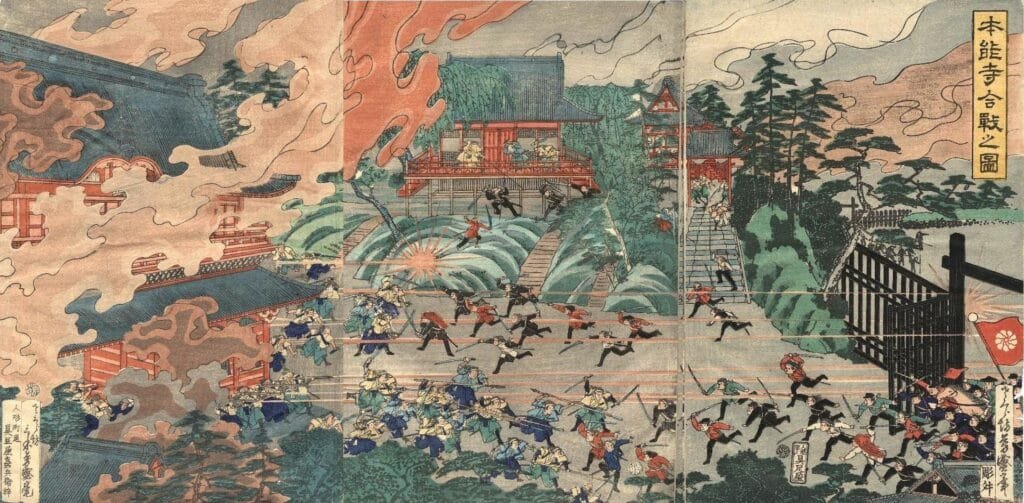The Boshin War was a civil war fought by the Tokugawa Shogunate against the Imperial forces. After more than two hundred and fifty years of Tokugawa dominion the dissatisfaction of nobles started to boil. But the increased influence of Western powers led to a decline in the economy. Even partisan violence in Edo by pro Emperor citizens. Meanwhile the Shogun were seen as no more almighty after the Convention of Kanagawa after the surrender to US forces.

East against West in Japan in The Boshin War
Japan still today sometimes breaks up into West and East. With the Capital city of Tokyo on the East and Kyoto, the ancient Imperial Capital on the West. This was the background to the Boshin War as well. Tokugawa on the East, the Samurai de facto Capital of Edo. With the young Emperor Meiji in Kyoto.
The Western Samurai domains were getting richer and powerful thanks to the commerce with European powers. And far away from Edo they started to plot a Rebellion against the Shogun. Mostly the domains of Satsuma, Choshu and Tosa. With Sakamoto Ryouma being a representative of the Tosa Domain and a pro Imperial Japan in Kyoto among others.
The Choshu domain was looking forever since the Sengoku period to overthrow the Shogun. In revenge to Tokugawa Ieyasu defeated Toyotomi and left Chousuu in hands of allied troops between the Domain. But a coup d’etat restored the power in the hands of anti Tokugawa factions. In 1867 Choushuu and the Satsuma domain (today’s Kagoshima) formed a secret alliance against the Shogun. This together with a proposal from the Tosa Domain made young Shogun Tokugawa Yoshinobu resign his authority over the Emperor. Ended the Tokugawa Shogunate
The Meiji Restoration and the last Shogun
Tokugawa Yoshinobu’s resignation left a nominal void in power. But the Tokugawa family remained a powerful force in Edo. The fifteen years old Emperor Meiji declared his own restoration to supreme law in January 1868. And a coalition from Western domains accepted this together with a proposal to restore the Shogun and continue to reign as collaboration between the Emperor Meiji and Tokugawa Yoshinobu.
Takamori Saigo was the most influential voice from the Satsuma Domain. And he called for the definitive abolition of the Shogun Title. The last Shogun Tokugawa Yoshinobu who initially agreed on the Emperor’s new ruling called for the repeal of the Meiji Restoration. Yoshinobu decided to attack Kyoto. But the forces of Satsuma and Choushuu were controlling the Imperial City proclaiming the abolition of Tokugawa rule.

The Toba Fushimi Battle
Tokugawa attacked Satsuma and Choshu forces near Toba and Fushimi south of Kyoto. Was at first another battle between domains against the Tokugawa rule. The Shinsengumi was an important figure on the Shogun side. The Edo group was a feared force already in Kyoto. Even when many of their members were loyal to the Emperor as well. But on the second day Ninnajimomiya Yoshiaki became the commander in chief. He was a relative of the Emperor. And the banner of the Imperial house was raised on the Satsuma and Choshu side. Many domains on the side of Tokugawa defected to the side of the Emperor.
Takamori Saigo led the Imperial troops after winning the battle of Toba Fushimi. East into Edo. In 1868 Katsu Yasuyoshi, the Army Minister of Tokugawa, signed the surrender.

The Republic of Ezo
But the leader of the Tokugawa Navy was not ready to surrender. Enomoto Takeaki fled north commanding eight steam warships and more than two thousand personnel. Some domains around Edo keep supporting the Shogun. Being Aizu the more notorious one with Saito Hajime as their famous representative. Even after the defeat of the Shinsengumi at the battle of Bonari.
The independent Republic of Ezo was established on January 27, 1869, in Hokkaidou. As the president, Enomot tried to garner recognition and support from the US, Russia and France. But without any response from the Western powers he offered to confer the territory to the Tokugawa Shogunate. But it was declined by the Imperial House of the Chrysanthemum.
Battle of Hakodate and end of The Boshin War
The Imperial Navy reached Miyako Bay on March 20. Hijikata Toshizou led three warships against the Imperial forces. The Imperial Navy won the battle progressing into Hakodate. But the commander of the Shinsengumi lost his life in the last battle of the Boshin War, in Hakodate. Enomoto Takeaki surrendered on June 27, 1869. The Ezo Republic ceased to exist. And the Emperor House returned to power after more than two hundred and fifty years of Tokugawa dominion. Emperor Meiji suppressed the Samurai Class. And he founded the Yasukuni Shrine to honor the victims of the Boshin War.